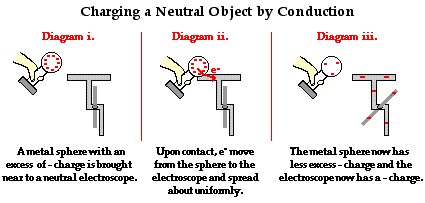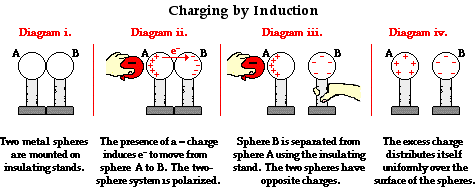Charge Transfer: Difference between revisions
| Line 33: | Line 33: | ||
http://www.physicsbook.gatech.edu/Charge_Motion_in_Metals | http://www.physicsbook.gatech.edu/Charge_Motion_in_Metals | ||
http://www.physicsbook.gatech.edu/Polarization | http://www.physicsbook.gatech.edu/Polarization | ||
| Line 42: | Line 43: | ||
Internet resources on this topic: | Internet resources on this topic: | ||
http://www.physicsclassroom.com/class/estatics/Lesson-1/Conductors-and-Insulators | http://www.physicsclassroom.com/class/estatics/Lesson-1/Conductors-and-Insulators | ||
http://www.physicsclassroom.com/class/estatics/Lesson-1/Charge-Interactions | http://www.physicsclassroom.com/class/estatics/Lesson-1/Charge-Interactions | ||
Revision as of 04:57, 3 December 2015
claimed by Lzhang375
If a charged conductor comes in contact, or is in close enough proximity, with another conductor, it is possible to transfer this charge to the second conductor. This process is called charge transfer. Charges cannot be created or destroyed; this is known as the Law of Conservation of Charge. Therefore, in the transfer of charge between two objects, the amount of charge gained by one object is equal to the amount of charge loss by the other. There are multiple ways that charge can be transferred such as through direct contact and through inductance.
Insulators vs Conductors
In an insulator, electrons are bounded tightly to atoms, which prevents charged particles from moving through the material. If charge is transferred to an insulator at a given location, the charge will remain at the location that the transfer occurred.

On the other hand, electrons are able to flow freely from particle to particle within conductors. When charge is transferred to a conductor, the charge is distributed evenly across the surface of the object via electron movement. The electrons will be distributed until the repelling force between the excess electrons is minimized. This is the main difference between insulators and conductors: insulators do not have mobile charged particles whereas conductors have mobile charged particles that allow for charge transfer through the free movement of electrons. Examples of insulators include rubber and air and examples of conductors include metals and salt water.
Transfer Charges by Conduction
Electrons move from one object to another (especially with metals) through points of contact. An example of this is rubbing a glass rod with silk. The glass rod will become positively charged and the silk will become negatively charged; this means that electrons were transferred from the glass rod to the silk, since protons are not removed from the nuclei. Rubbing two objects together is not necessary for charge transfer, but because rubbing creates more points of contact between two objects, it facilitates charge transfer.
Transfer Charges by Induction
induction is the movement of electrons to one part of an object that is caused by the electric field of a second object. the electric field around the charged object attracts or repels electrons in the second object. polarizes give neutral object a charge by moving a charged object near it, then grounding or taking away the other charge with hand or conductor, and then remove both so that resulting object is charged example is rubbing balloon on hair to get negative charge, then put balloon close to black pepper, the black pepper particles will jump up and stick to the balloon because the particles were polarized so that it becomes positively charged on top and will be attracted the negatively charged balloon. electrons on the bottom of the black pepper will be grounded into the surface its sitting on, so that the black pepper particles become psotively charged.
Connectedness
- How is this topic connected to something that you are interested in?
- How is it connected to your major?
- Is there an interesting industrial application?
See also
http://www.physicsbook.gatech.edu/Charge_Motion_in_Metals
http://www.physicsbook.gatech.edu/Polarization
Further reading
Books, Articles or other print media on this topic
External links
Internet resources on this topic:
http://www.physicsclassroom.com/class/estatics/Lesson-1/Conductors-and-Insulators
http://www.physicsclassroom.com/class/estatics/Lesson-1/Charge-Interactions
References
This section contains the the references you used while writing this page

